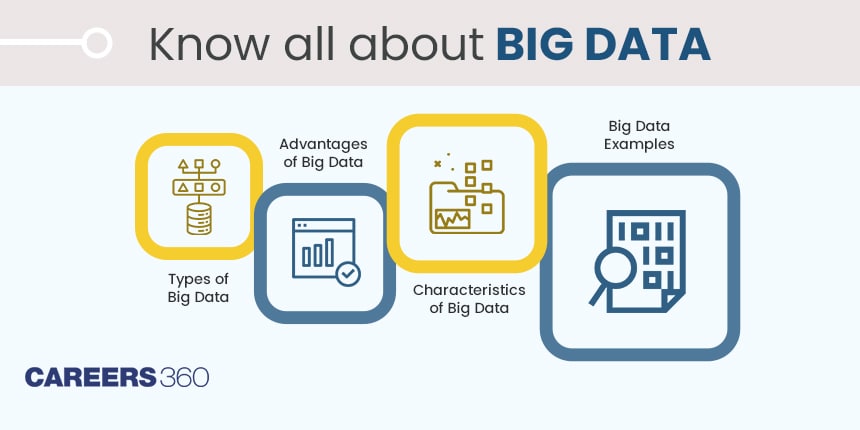Symbiosis-SITEEE-2025
Gateway for admissions to Engineering courses @ Symbiosis | NAAC A++ Grade | Among top 31 in India (NIRF 2024)
In digital transformation, businesses and organisations are involved with vast amounts of data. This influx of heavy volume information, commonly known as Big Data, has become a cornerstone for decision-making, innovation, and competitive advantage. As the digital landscape evolves, the sheer volume, velocity, and variety of data generated pose both challenges and opportunities.

In this article, we will explore the concept of Big Data, its types and advantages, and provide real-world examples to illustrate its pervasive impact. If you are interested in further exploring this field you can pursue some of the Big Data Certification Courses listed on our website.
Understanding the detailed landscape of Big Data necessitates a closer examination of its diverse types, each contributing a unique dimension to the vast pool of information that organisations grapple with daily. In this section, we will explore each types of big data, exploring their characteristics and applications, to provide a comprehensive understanding of the multifaceted nature of Big Data.
Data that is highly organised by using labels, and easily searchable. It is typically stored in relational databases and represented in tables with rows and columns.
Example: Customer information in a CRM system.
Data that lacks a predefined data model or structure. It can include text, images, videos, and social media posts. This usually requires a lot of data preprocessing before the data is finally ingested into a structural format.
Example: Social media comments and posts.
Data that is partially organised and may contain tags or other markers to separate elements within the data.
Example: XML or JSON files.
Also Read:
The characteristics of Big Data shape how organisations harness, analyse, and derive insights from this ever-expanding sea of information. The following points highlights the key characteristics of big data:
Big Data involves large amounts of data that surpass the capacity of traditional databases.
Data is generated at an unprecedented speed, requiring real-time or near-real-time processing and analysis.
Big Data comes in diverse formats, including structured, unstructured, and semi-structured data.
Refers to the reliability and accuracy (quality) of the data. Big Data often involves dealing with data of uncertain provenance.
The primary objective of Big Data is to extract meaningful insights and value from the vast amounts of data.
Also Read:
The features of Big Data that distinguish it from its capacity for handling massive volumes of information to its real-time processing capabilities and the ability to extract meaningful insights - empower enterprises to make informed decisions, innovate with precision, and gain a competitive edge. The following points highlight the advantages of big data:
Big Data analytics enables organisations to make data-driven decisions by extracting valuable insights from large datasets. This also enables discovering hidden business patterns. and thereby opening new revenue streams.
Businesses can optimise their operations by analysing data to identify areas for improvement and efficiency.
Big Data allows organisations to understand customer behaviour, preferences, and feedback, leading to personalised and improved customer experiences.
Companies can gain a competitive edge by leveraging Big Data for innovation, product development, and market insights.
Big Data analytics helps in identifying and mitigating potential risks by analysing patterns and trends.
Also Read:
These big data examples illustrate how organisations leverage the three Vs - volume, velocity, and variety - of data to extract meaningful insights, drive innovation, and gain a competitive edge in today's data-driven era. The following points highlights the examples of big data:
Analysing patient records, medical imaging, and genomic data for personalised treatment plans.
Detecting fraudulent activities by analysing vast amounts of transaction data in real-time.
Utilising customer data for personalised marketing, inventory management, and demand forecasting.
Optimising routes, predicting maintenance needs, and improving overall efficiency in logistics.
Analysing user behaviour, sentiment analysis, and targeting advertisements based on preferences.
Related: Popular Big Data Courses From Top Providers
Big Data has become an integral part of our modern world, influencing how businesses operate and make decisions. With its voluminous, high-velocity, and diverse nature, Big Data presents both challenges and opportunities. Organisations that harness the power of Big Data can gain valuable insights, improve operational efficiency, and stay competitive in the dynamic landscape of the digital age.
As technology continues to evolve, the benefits of Big Data in driving innovation and informed decision-making are likely to grow, shaping the future of aspiring big data analytics engineers.
Big Data refers to vast volumes of data characterised by high volume, velocity, and variety.
The benefits include improved decision-making through data-driven insights, enhanced operational efficiency, personalised customer experiences
It is categorised into structured, unstructured, and semi-structured types. Structured data is highly organised, unstructured lacks a predefined structure, and semi-structured falls in between with partial organisation.
The key characteristics include volume (large amounts of data), velocity (high speed of data generation), variety (diverse data formats), veracity (reliability of data), and value (extracting meaningful insights).
Challenges may include issues related to data security, privacy concerns, the need for advanced analytics tools, and the complexity of managing and analysing vast amounts of data.
Application Date:20 January,2025 - 18 April,2025
Ranked amongst top 3% universities globally (QS Rankings)
Ranked #1 Among all Private Indian Universities in QS Asia Rankings 2025 | Scholarships worth 210 CR
MSc Finance and MSc International Management Admissions 2025 Now Open | Ranked Among the Top 100 Universities in the World by QS World University Rankings 2025 | Last Date: 28th Apr'25
NAAC A++ Grade | Only Indian University member in the Global Liberal Arts Alliance
Ranked amongst top 3% universities globally (QS Rankings)
Ranked #42 among Engineering colleges in India by NIRF | Highest CTC 50 LPA , 100% Placements | Last Date to Apply: 28th April